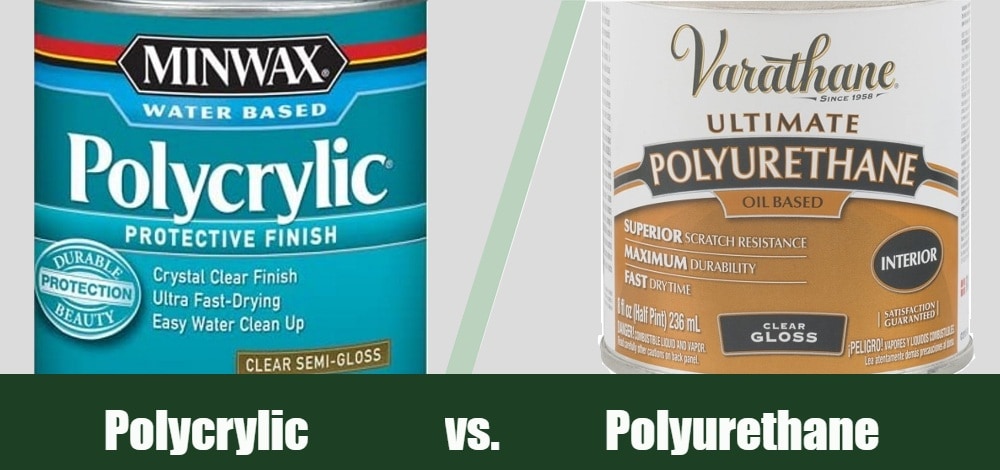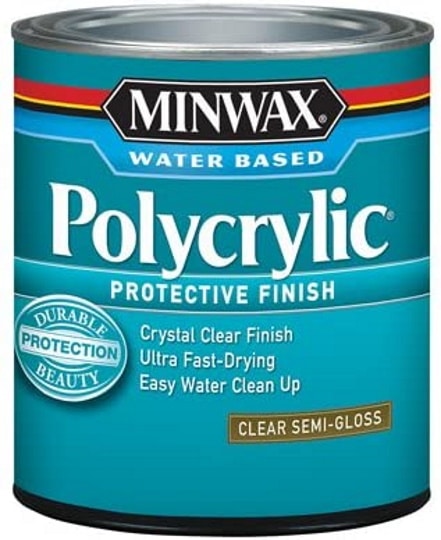Polycrylic vs Polyurethane: What’s the Difference?
-
Chris Dinesen Rogers
- Last updated:


You’ve just finished a DIY project. Now you want to put a finishing touch on your work to protect all your hard work. Which should you choose, polycrylic or polyurethane? While the names may sound similar, the two products are quite different. Each one offers its set of pros and cons that are worth considering. Both can give you the finish you want with or without a tint. They can also emphasize the wood grain.
It often comes down to a question of use. That means whether the finished piece is a focal point in a room and how much wear it’ll likely get. If the latter is a significant consideration, then you’re best off going with polyurethane that will handle the treatment an object will receive. However, that doesn’t mean polycrylic doesn’t have its place. Let’s do a deep dive and discuss when to use each product.

Overview of Polycrylic:

Polycrylic is the new kid on the block. You can get it in the ultra-flat, matte, satin, semi-gloss, or high-gloss finish that you want. The primary difference is that it’s water-based, making it an eco-friendlier option. That also means it’s easier to clean up after you’re done. You don’t need special products to get the stuff off your brushes. Depending on the job, you can get it either in a spray or roll-on formula.
How it Works
Polycrylic covers the surfaces of the objects you want to protect with a clear coat—if you have a light hand with it. That makes it a better choice for light-colored woods, such as maple, instead of dark ones. You must apply it in a thin coat no matter which type you use. It dries relatively quickly since it’s water based. It also doesn’t have fumes or volatile organic compounds (VOCs) of oil-based finishes.
When to Choose It
Polycrylic works best with objects that don’t get heavy use. It provides a coating that isn’t quite as durable as other products. It would help if you chose it only on items you’ll keep inside your home. It won’t handle the elements as well as oil-based finishes. On the positive side, it is more budget-friendly. Its fast-drying times mean that you can use what you’ve applied it too quickly.
That can make a significant difference if you have pets. There’s less of a risk that stray hairs will mar the finish of your project. It’s also a factor if you have small children.
- Economically priced
- Quick-drying
- Water-based
- Difficult to get right

Overview of Polyurethane:

Polyurethane has been the old standby for decades because of the durable finish it provides. You’ll find products that are either water-based or oil-based. The former offers some of the benefits of polycrylic with its quicker drying times and fewer fumes. However, it also is more challenging to apply because of its thinner consistency. You may also have to put on two or more coats to get the durability you need.
Oil-based products are the gold standard for finishes. They form a hard coating that provides excellent protection against use and the elements. On the downside, they take longer to dry, requiring you to keep it someplace safe until you can use it. There are also fumes. It’s worth noting that ventilation is a requirement no matter which product you use.
How it Works
Water-based products will go on opaque and dry to a clear finish. You can also clean up afterward with just soap and water. Oil-based polyurethane is thicker and hence, dries slower. If you’re doing multiple coats, that can significantly impact completing your project. However, the result is a rock-hard finish with a slight yellow tint that many people find pleasing.
When to Choose It
The use that an object will get is the deciding factor that may tip the scale toward polyurethane. Even with heavy use, you may find that the finish will hold up for several years. While ventilation is always a factor, it’s more so when you use an oil-based product. That can affect when you finish your project if you can’t move it outdoors.

- Oil-based or water-based
- Durable finish
- Professional-looking results
- Long drying times

Other Factors to Consider
You may find the application of polycrylic vs. polyurethane a deal-breaker when taken with the type of project you’re completing. Both polycrylic and water-based polyurethane have a runnier consistency that makes them best for smaller items. You may find that drips and mistakes are more visible if you’re not careful. It becomes more of an issue with larger surfaces because of the drying time.
Polyurethane is not without its quirks, too. For example, it’s imperative not to shake the can before you use t. The thicker consistency means that the air bubbles will stay in the solution longer. When you apply it, they will inevitably pop, leaving unsightly marks and bare spots in the finish. However, it offers a more manageable option if you’re finishing a vertical surface since it is less likely to drip.

The Cost Factor
The other stark difference between polycrylic and polyurethane is the cost. The latter is considerably more expensive than the former. However, balancing the price with the time and effort of applying the finish is essential. You may get more years out of a heavily used item with polyurethane than a polycrylic finish. We suggest that you consider how easy it is to complete the project regardless of the product you use.
| When to Use Polycrylic | When to Use Polyurethane |
| Budget factor | Professional results |
| Finish not a consideration | High-quality finish |
| Quick-drying | Longer drying times |
| Indoor project only | Indoor or outdoor projects |
| Small surfaces. | Any size surface |
Related Read: How Many Coats of Polyurethane Do I Need? Solved!

Conclusion
It used to be that you only had one choice for choosing a finish for your wood items, floors, or furniture. Polycrylic and water-based polyurethane offer other options to overcome some of the challenges and disadvantages of working with oil-based products. However, all have their pros and cons. It is essential to think about projects and their typical use before choosing a finish to get the best one for the job.
Contents
